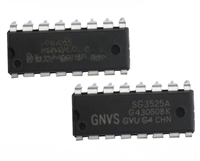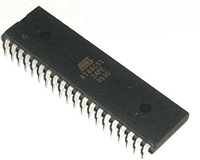IDT821068 OCTAL PROGRAMMABLE PCM CODEC
INDUSTRIAL TEMPERATURE RANGE
C/I CHANNEL
For example: Data is placed onto the DD Monitor Channel by the
In both compressed GCI and linear GCI mode, the upstream and Monitor Transmitter of the master device (DD MX bit is activated and
downstream C/I channel bytes are continuously carrying I/O information set to ‘0’). This data transfer will be repeated within each frame (125
every frame to and from the IDT821068. In this way, the upstream ms rate) until it is acknowledged by the IDT821068 Monitor Receiver
processor can have an immediate access to SLIC output data present by setting the DU MR bit to ‘0’, which is checked by the Monitor
on IDT821068’s programmable I/O port on SLIC side through Transmitter of the master device. Thus, the data rate is not 8 kbytes/s.
downstream C/I channel, as well as to SLIC input data through upstream
C/I channel. The IDT821068 transmits or receives the C/I channel data Monitor Handshake
with the Most Significant Bit first.
The monitor channel works in 3 states:
The MR and MX bits are used for handshaking during data
exchanges on the monitor channel.
I. Idle state: A pair of inactive (set to ‘1’) MR and MX bits during two
or more consecutive frames shows an idle state on the monitor
channel and the End of Message (EOM);
Upstream C/I Channel
II. Sending state: MX bit is activated (set to ‘0’) by the Monitor
The C/I channel which includes six C/I channel bits, is transmitted Transmitter, together with data-bytes (can be changed) on the monitor
upstream by the IDT821068 every frame. The bit definitions for the channel;
upstream C/I channel are shown below.
Upstream C/I Octet
MSB
III. Acknowledging: MR bit is set to active (i.e. ‘0’) by the Monitor
Receiver, together with a data byte remaining in the monitor channel.
A start of transmission is initiated by a monitor transmitter by
sending out an active MX bit together with the first byte of data to be
transmitted in the monitor channel. This state remains until the
addressed monitor receiver acknowledges the receipt by sending out
LSB
b7
b6
b5
b4
b3
b2
b1
b0
SI1(A) SI2(A) SB1(A) SI1(B) SI2(B) SB1(B)
MR
MX
The logic state of input ports SI1 and SI2 for channel A and channel B, an active low MR bit. The data transmission is repeated each 125 ms
as well as the bidirectional port SB1 for channel A and B if SB1 is frame (minimum is one repetition). During this time the Monitor
programmed as an input, are read and transmitted in the upstream C/I Transmitter keeps evaluating the MR bit.
channel. When SB2 is programmed as input, its data are not available in
upstream C/I channel and can be read by Global Command 12 only.
Flow control, means in the form of transmission delay, can only take
place when the transmitters MX and the receivers MR bit are in active
state.
Downstream C/I Channel
The downstream C/I octet is defined as:
Downstream C/I Octet
Since the receiver is able to receive the monitor data at least twice
(in two consecutive frames), it is able to check for data errors. If two
different bytes are received the receiver will wait for the receipt of two
MSB
b7
A/B
LSB identical successive bytes (last look function).
A collision resolution mechanism (check if another device is trying
b6
b5
b4
b3
b2
b1
b0
MX
to send data during the same time) is implemented in the transmitter.
This is done by looking for the inactive (‘1’) phase of the MX bit and
making a per bit collision check on the transmitted monitor data
(check if transmitted ‘1’s are on DU/DD line; DU/DD line are open
SO3
SO2
SO1
SB1
SB2
MR
Herein, A/B selects channel A or Channel B:
A/B = 0: channel A is selected; A/B = 1: channel B is selected.
The downstream C/I channel carries the SLIC output data bits of drain lines).
SO1, SO2 and SO2 for channel A or B, as well as SB1 and SB2 output
bits when SB1 and SB2 are programmed as outputs.
Any abort leads to a reset of the IDT821068 command stack, the
device is ready to receive new commands.
To obtain a maximum speed data transfer, the transmitter
anticipates the falling edge of the receivers acknowledgment.
Due to the inherent programming structure, duplex operation is not
MONITOR CHANNEL
The monitor channel is used to transfer of maintenance information
between the upstream and downstream devices. The information possible. It is not allowed to send any data to the IDT821068, while
includes reading/writing the global/local registers and coefficient/FSK transmission is active.
RAM of the IDT821068 or providing SLIC signaling and so on. Using
Refer to Figure 7 and 8 for more information about monitor
two monitor control bits (MR and MX) per direction, data is transferred handshake procedure.
in a complete handshake procedure. The MR and MX bits in the C/I
The IDT821068 can be controlled very flexibly by commands
operating on registers or RAMs via the GCI monitor channel, refer to
“Programming Description” for further details.
Channel of the GCI frame are used for the handshake procedure of
the monitor channel. See Figure 6.
The monitor channel transmission operates on a pseudo-
asynchronous basis:
- Data transfer (bits) on the bus is synchronized to FSC;
- Data flow (bytes) are asynchronously controlled by the handshake
procedure.
9






 SG3525资料手册详解:SG3525参数分析、引脚说明、应用介绍
SG3525资料手册详解:SG3525参数分析、引脚说明、应用介绍

 AT89C51单片机资料手册详细解析及应用示例
AT89C51单片机资料手册详细解析及应用示例

 CP2102资料手册解读:CP2102引脚说明、关键参数分析
CP2102资料手册解读:CP2102引脚说明、关键参数分析

 资料手册解读:UC3842参数和管脚说明
资料手册解读:UC3842参数和管脚说明
